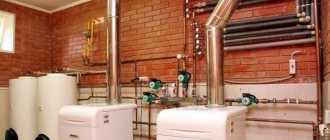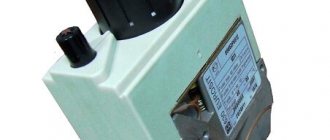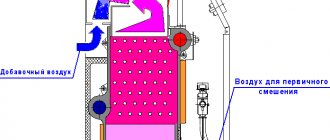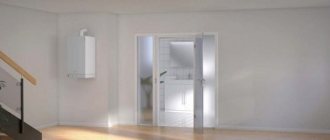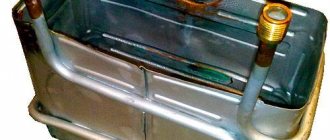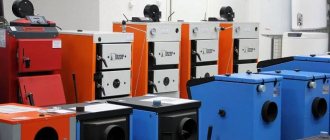The most effective way to heat your home is to install a gas boiler. A large number of models on the market can satisfy the needs of all categories of users. Choosing a gas boiler based on its technical parameters will help determine a product that will operate effectively for a long time without failures or extra costs.
Types and design of gas boilers
The device is an installation for creating thermal energy by burning fuel. A gas boiler is the most common type of heat generator, due to the cost-effectiveness of the substance and the reliability of the equipment.
Domestic and foreign industry produces a wide range of installations with very different characteristics.
Gas heating appliances are technological equipment that is made from durable materials. To ensure reliability, diagnostic sensors are provided, as well as a security system that blocks the operation of the boiler if a malfunction is detected.
According to design features, equipment can be divided into several groups.
For installation:
- floor;
- wall-mounted
By number of circuits:
- single-circuit;
- double-circuit.
By burner type:
- atmospheric;
- closed.
The main structural elements of the boiler are:
- gas burner - fuel releases energy in it;
- heat exchanger – energy heats circulating water;
- flue gas removal system;
- expansion tank - to compensate for fluctuations in coolant volume due to heating;
- complex with a self-diagnosis sensor;
- Control block.
In addition, many models use a circulation pump to pump coolant. Air supply and smoke removal are carried out by a fan.
Operating principle
A wall-mounted gas boiler does not require constant intervention. The entire process is controlled and regulated automatically; you just need to configure the equipment correctly.
The automation set in a certain mode turns the device on and off. Control of operating parameters is also carried out automatically. The system will not allow overheating or increased pressure, and will adjust the volume of liquid if necessary.
The gas burner heats the heat exchanger through which the coolant passes. With the help of a circulation pump, it is further moved in the heating system.
Principle of operation
Regardless of the type, the functioning scheme of all boilers is the same.
The smooth operation of the equipment is carried out according to the following algorithm:
- The sensor system measures the temperature - if it is below the set value, the thermostat controller opens the gas valve. Fuel enters the combustion chamber.
- Next, the electric or piezo ignition is triggered.
- As a result of the combustion reaction, the water circulating in the heating circuit begins to heat up in the heat exchanger.
- Having reached the temperature set by the thermostat, the automation turns off the burner.
This is how a single-circuit boiler works. To provide the house with not only heating, but also hot water, in addition to such an installation, you can connect an electric boiler or gas water heater.
Double-circuit boilers are capable of not only raising the temperature in the room, but also heating water.
But such installations cannot work simultaneously to generate heat and supply hot water. For a small private house or apartment, stopping the heating circuit for a short time is almost imperceptible.
If we are talking about a room of considerable area, the best solution would be to install equipment for heating and hot water supply, operating independently of each other.
Number of circuits
Single-circuit boilers can heat the room (if there is a central water supply). But the operating principle of double-circuit gas boilers is different. They not only heat the house, but also provide constant hot water.
Single-circuit gas boiler
It should be said here that as soon as you decide to use hot water, the double-circuit boiler will send its power to perform this task. This is why the water becomes warm only after a few seconds, and the room cools down a couple of degrees while someone is washing. But this is not critical and becomes commonplace, or you can use circuits for storing hot water.
Double-circuit gas boiler
Single-circuit gas boilers
- Take up a lot of space;
- Difficult installation;
- They can heat a large house;
- Thanks to their simple design, they are considered durable in use.
Double-circuit gas boilers
- Compact;
- Suitable for small spaces;
- They are demanding regarding the conditions of use, that is, in order to have hot water, you need high pressure from the main gas. Otherwise the water will be summer;
- They work more efficiently where there are two water supply points - the kitchen and the bathroom. If there are more points, then it is better to find another solution.
Moreover, despite the number of circuits, the advantage of any gas boiler is its high efficiency (up to 93%).
The principle of operation of single-circuit and double-circuit gas boilers
Specifications
Depending on the type of equipment, a different set of parameters is taken into account when selecting a model.
Wall-mounted devices are a ready-made heating system that is easy to install. They are economical, but sensitive to voltage changes in the electrical network. When installing a boiler in a private house, it is wise to install a good voltage stabilizer and an uninterruptible power supply.
When selecting a model for a wall-mounted unit, the most important technical characteristics are:
- installation power – selected based on the area of the room;
- efficiency - fuel consumption depends on the parameter; for most wall-mounted models this indicator changes slightly;
- noise - important when installing equipment in a residential area;
- heat exchanger material - most models are equipped with a copper or steel coil, some use aluminum, which is cheaper, but has lower thermal conductivity and corrosion resistance;
- the presence of additional functions - different devices are equipped with their own list of capabilities;
- the material from which the internal parts of the boiler are made - plastic is used in cheap models, brass is used in expensive boilers.
Floor heating devices are difficult to install. Incorrect installation may cause service problems. However, this technique is insensitive to voltage surges, durable, and reliable.
For floor structure equipment, it is worth considering the following characteristics:
- power - it is recommended to take a boiler with a reserve, since in the cold season the indicator decreases;
- heat exchanger material - in stationary models steel or cast iron is used;
- Dimensions – floor units may differ in height and width;
- energy dependence - complex expensive devices are equipped with automation powered by electricity; simple devices do not require a network connection;
- Efficiency - the spread of this parameter for floor-standing installations varies over a wide range.
Advantages and disadvantages
Wall-mounted boilers do not require a separate room - they are installed anywhere in the apartment.
Each model has its own characteristics. The equipment is in high demand for a number of reasons:
- no need for a separate boiler room;
- compactness;
- autonomy;
- high efficiency;
- efficiency compared to devices running on other types of fuel;
- possibility of connecting to a gas cylinder and mains;
- easy operation.
There are also disadvantages:
- low power;
- dependence on electricity, sensitivity to power surges and the need to install an RCD for volatile models;
- installation permit is required.
The coolant for gas wall-mounted boilers must be of high quality.
What is the difference between a floor-standing gas boiler and a wall-mounted one?
In the first case, the units have medium or high power. They differ in greater mass. The power of such a device can exceed 300 kW. The installation is capable of effectively heating residential, domestic and commercial premises of considerable area.
The main design difference between a floor-mounted heating device and a wall-mounted one is the heat exchanger. In the first case, it is larger and more massive. Material: alloy steel or cast iron. The latter has increased fragility, but is resistant to corrosion, has high thermal conductivity, and is durable. At the same time, floor-standing devices can be either completely energy-independent or operate when connected to the mains.
Wall-mounted boilers are equipped with heat exchangers made of steel or copper. The service life of such installations is shorter. They are convenient to use for heating residential premises. They operate quietly, have small dimensions and weight. All wall-mounted units are energy-dependent. For the operation of the pump and fan, which ensure the movement of the coolant, as well as the removal of flue gases, a connection to the electrical network is required.
Features of connection and operation
Requirements for boiler installation
A simple modification of a wall-mounted boiler can be installed independently if the manufacturer notes this possibility in the technical documentation. In any case, connection to the gas main and verification of correct installation must be carried out by a licensed specialist. It is allowed to independently connect the device to the heating system and water supply. After checking the correct installation by a gas service specialist, a permit to operate the boiler is issued. You cannot use the boiler without this document, otherwise the owner will face fines.
Before installing the boiler, it is necessary to develop and approve a project for laying gas pipes and connecting equipment. After approval of the project, the boiler is installed, strictly observing all the requirements of the design documentation. A meter and a shut-off valve must be installed on the supply pipe.
The room where the device is installed must have a window with a window. The wall on which installation is carried out must be finished with non-combustible materials. Measures should also be taken to increase the efficiency of the ventilation system to ensure sufficient air exchange and minimize gas pollution in the room. It is recommended to make a hole in the kitchen door with an area of at least 0.02 m2 and cover it with a grill.
How to choose boiler power
The decisive factor in calculating this equipment indicator is the area of the heated room. There must be at least 1 kW per 10 m². This principle makes it possible to estimate the required power of the installation as a first approximation. Moreover, this calculation is correct for a building with an insulated attic, good thermal insulation, and double-glazed windows. The climatic conditions correspond to central Russia.
More accurate power calculations should include the following parameters:
- room dimensions;
- heat loss of the building;
- temperature fluctuations indoors and outdoors;
- energy consumption for hot water supply;
- insulation of the room.
It is most convenient to select an installation using specialized software.
The calculations must take into account that the actual power of the device may be less due to ventilation.
To compensate for losses, it is recommended to increase the obtained value by 10-20%. When using a boiler for hot water supply, it is advisable to add an additional 20-25%.
Choosing a unit with excess power is undesirable - this leads to higher prices for heating equipment, increased fuel costs, and increased wear and tear of equipment components.
Rules for calculating equipment power
It’s worth remembering right away that the desire to save money on designing a heating system and performing thermal calculations in most cases backfires on the customer. If you think through everything carefully and trust a highly qualified specialist, then the cost of the boiler, radiators and other equipment will be much cheaper.
The power of the heating boiler is selected to calculate the distribution of approximately 0.1 kW per m2 of living space
To approximate the power of heating equipment required to heat a building and provide hot water supply, you can use special design standards.
It is also imperative to take into account:
- the number of people who will live in the house;
- building materials used for housing construction;
- climate zone;
- number of windows and doors;
- number of floors and other factors.
The opinion that the boiler power is selected at the rate of 0.1 kW per square meter is quite common. But thanks to modern building materials and innovative engineering equipment, heat losses can be significantly lower and, accordingly, the performance of heating equipment can be higher.
Types of heat exchangers
When choosing heating equipment, the material used plays an important role. The energy efficiency and reliability of the system depend on it.
The efficiency of a device with a copper heat exchanger is higher and the size is smaller, so this metal is used in wall-mounted models.
Cast iron is used for stationary floor-mounted installations of high power. The density of the material makes it unsuitable for use in compact boilers. Cast iron is durable.
The disadvantage of the material is the likelihood of condensation forming on the surface of the heat exchanger when the temperature drops to 60 °C. This can cause erosion of the metal and then lead to microcracks. Copper has no such drawback, so the operation of equipment made from this material does not depend on temperature changes.
Many models of gas boilers are equipped with steel heat exchangers. The material occupies an intermediate position between cast iron and copper. Metal is used in both floor-standing and wall-mounted devices. It is stronger than cast iron, but has lower thermal conductivity than copper. Steel appliances are susceptible to temperature changes, and the material is sensitive to corrosion due to condensation of water vapor.
If your budget allows, it is wise to opt for a model with a copper heat exchanger. However, the material is used mainly in wall-mounted appliances.
Boiler for home heating prices
Prices for heating systems vary significantly and depend on many factors.
If you need the most budget option for a country house or cottage, then an electric boiler is suitable, solid fuel is in second place, followed by diesel, and the most expensive type is considered a combination boiler. There is no doubt that a gas heating boiler that uses gas to maintain its operation is less expensive.
But don't take prices literally. To correctly calculate the cost, you need a full calculation that takes into account all the factors affecting the total amount (installation, operation, payment for fuel, heating area, etc.).
To understand which gas boiler is best for a country house (cottage), you can contact specialists so that you do not have to select it yourself. They will select the option that suits your requirements.
Selection based on combustion chamber
Boilers can be open or closed. The first uses air directly from the room. In this case, it is necessary to install a chimney. Boilers with an open or atmospheric combustion chamber are mainly installed in separate rooms. Similar types of gas boilers are used in floor-standing installations with a power of more than 35 kW.
In a closed combustion chamber, a coaxial chimney is used to supply air and remove flue gases. This device consists of two pipes of different diameters, the first is inserted into the second. Air is supplied to the burner through one channel, and the combustion product is discharged through the other. The closed type is used mainly in wall-mounted units.
Manufacturers, reviews, estimated prices
The seller’s task is to sell the boiler. Therefore, do not expect that the shortcomings of each model will be objectively pointed out to you. Carefully read user reviews before purchasing. They convincingly reveal the weak points of the design.
A well-known brand is a strong argument in favor of choice. This is a concentrated expression of manufacturing experience, level of technology, quality of materials and workmanship.
When choosing an economical gas boiler for heating your home, pay attention to such popular German brands as Vaillant and Bosch.
They are reliable and consume a minimal amount of gas. Reviews of their work are mostly positive. The minimum price of a wall-mounted 2-circuit Vaillant boiler (atmospheric) with a power of 24 kW (heating area up to 240 m2) starts from 35 thousand rubles. A Bosch boiler with similar characteristics is significantly cheaper (from 23 thousand rubles). The approximate prices of atmospheric units from these companies (floor-mounted version, heating area up to 320 m2) start from 60 thousand rubles.
Italian brands Baxi (baxi), Ariston (Ariston), Ferroli (Ferroli), Korean Navien (Navien) with fairly high quality equipment are affordable for most homeowners. In customer reviews you will find more positive ratings than outright negativity.
Prices for wall-mounted atmospheric models (24 kW) here start at 25,000 rubles. Floor-standing installations of these companies (heated area up to 300 m2) cost customers from 50 thousand rubles.
The heating equipment of the domestic company Lemax and the Slovakian Protherm have proven themselves well. Floor-standing Proterm models with an atmospheric burner (power 35 kW) can be purchased for 40 thousand rubles, and wall-mounted 24-kilowatt double-circuit boilers for 25-26 thousand rubles.
Floor-standing atmospheric Lemax units with a power of 35 kW (single-circuit) can be purchased for 34,000 rubles. For a wall-mounted atmospheric double-circuit unit from this company (heating area 250 m2), sellers ask from 19,000 rubles.
Unlike other brands, Lemax also works in the category of low-power floor-standing single-circuit boilers (from 7.5 to 16 kW), offering them at prices from 12 to 16 thousand rubles.
Rating of the best gas boiler manufacturers
The reliability and stability of heating in a private home depends on the operation of thermal equipment. Increasingly, users are installing a gas boiler in their apartment. Saving in both cases when selecting it is impractical.
Among manufacturers producing boilers, the following brands are popular with consumers:
- Buderus is a company of German origin that produces reliable wall and floor models. There are devices with cast iron heat exchangers. The product line includes devices with open and closed burner.
- Navien is a Korean manufacturer with official representative offices in Russia, the USA and other countries. The products are famous for their unpretentiousness, low noise level, and operational reliability. Navien boilers are distinguished by their low gas pressure requirements.
- Bosch - a company from Germany is famous for the reliability of its equipment. The manufacturer produces a full range of gas equipment for domestic use. The boilers are distinguished by increased operational safety and convenient control.
- Vaillant is a German brand popular in the gas equipment market. The company produces boilers with a closed and open combustion chamber with a power from 4 to 240 kW. The products are equipped with a reliable safety system, including protection against freezing, overheating and pump blocking. There is a wide network of service centers throughout Russia.
- Viessmann is a manufacturer that produces reliable heating and water heating equipment. The line of gas boilers includes single- and double-circuit models for floor and wall installation. The devices are environmentally friendly and have low noise levels. There is built-in protection against power surges. Many models can use both natural and liquefied gas as fuel.
- Ariston is an Italian brand, along with household appliances, offering gas equipment for heating and hot water supply. The boilers are famous for their high efficiency and low energy consumption. The devices are equipped with pump stop protection, flame modulation, and a semi-automatic ignition system. Thanks to the stylish design, the equipment looks good in the interior.
- Baxi is a company from Italy that produces water heating and heating equipment. The product line includes convection and condensing boilers of different capacities and designs. They are equipped with a good system for ensuring safe operation. There is a flame modulation mode that helps reduce fuel consumption. Built-in automation responds to changing weather conditions.
- Lemax is a Russian brand that produces reliable, inexpensive installations using components from foreign manufacturers. Models available for floor and wall installation. The devices are adapted for Russian conditions: they can be operated at low gas pressure, and the voltage range has been expanded. Composite materials are used in manufacturing. A wide network of service centers allows you to quickly resolve any problems that arise.
- ZhMZ - products of the Zhukovsky Machine-Building Plant are popular in the budget segment of the market. The devices have a full range of basic functions and are well adapted to work in Russian conditions. There is gas pressure control, non-volatile ignition, and overheating protection. German-made automation is used. The devices are designed to operate on natural and liquefied gas.
- Neva is a Russian company from St. Petersburg that produces heating equipment of several modifications. Boilers with one and two circuits are available. The copper heat exchanger is highly efficient and resistant to temperature changes. The safety system includes protection against freezing, overheating, and pump blocking. The auto-diagnosis function allows you to quickly identify malfunctions in the installation.
By choosing a boiler manufactured by one of the manufacturers listed above, you can be sure of its long-term reliable operation.
Smart electronics
You can choose a gas boiler for heating a private home with additional functions that, although they increase its cost, make operation safe and convenient:
- Flame sensor – turns off the gas supply independently if there is no flame;
- Blocking – the program turns off the boiler if the gas supply stops;
- Traction control sensor - ensures that carbon monoxide does not form so much that it becomes dangerous, and ensures that the device operates without accidents.
Selecting a location for heating equipment
All types of heating boilers are produced mainly in a floor-standing version, electric in a wall-mounted version, and gas in both a wall-mounted and a floor-mounted version. The latest variation is best installed in a spacious separate room. Such heating equipment is characterized by great power and massiveness.
A wall-mounted boiler will be an ideal solution for small-sized houses, where every square meter counts
And due to the fact that the weight of floor-standing boilers is not limited in any way, manufacturers install a cast-iron heat exchanger in it, which is much more reliable than a steel one.
Wall-mounted heating equipment is compact in size and fairly light in weight. But this type of boiler is limited in power. This minus is especially relevant for dual-circuit systems - the performance of the heating circuits will be quite low.
You should choose wall-mounted boilers only if the heated area does not exceed 200 m2 and the hot water consumption is no more than 14 l/min. If the needs are greater, then it is better to give preference to the floor-mounted variation of heating equipment.
It should be noted that many buyers, regardless of the size of their living space, prefer floor-mounted systems that are equipped with a cast-iron heat exchanger. After all, such devices are less demanding on the quality of power supply.


